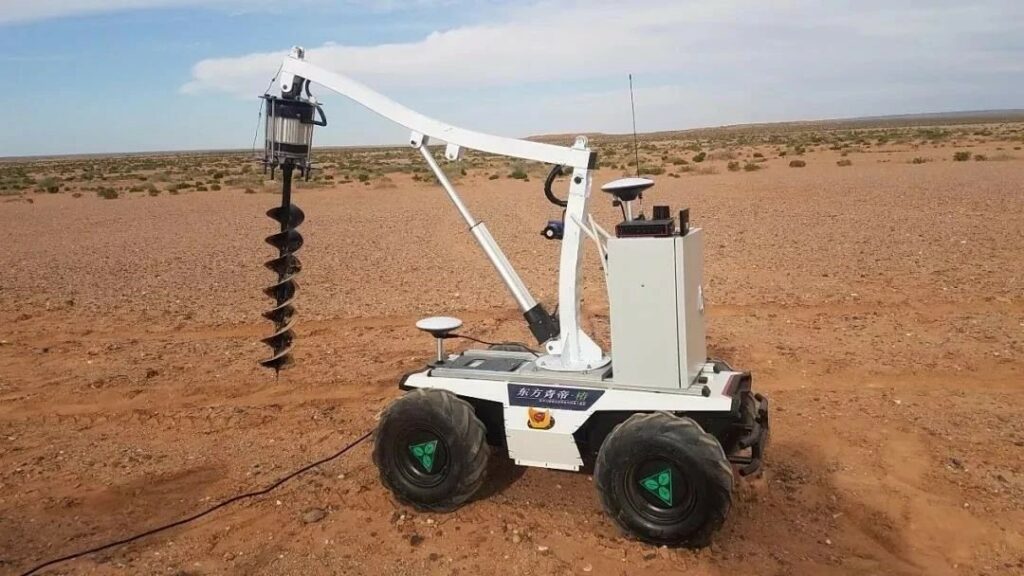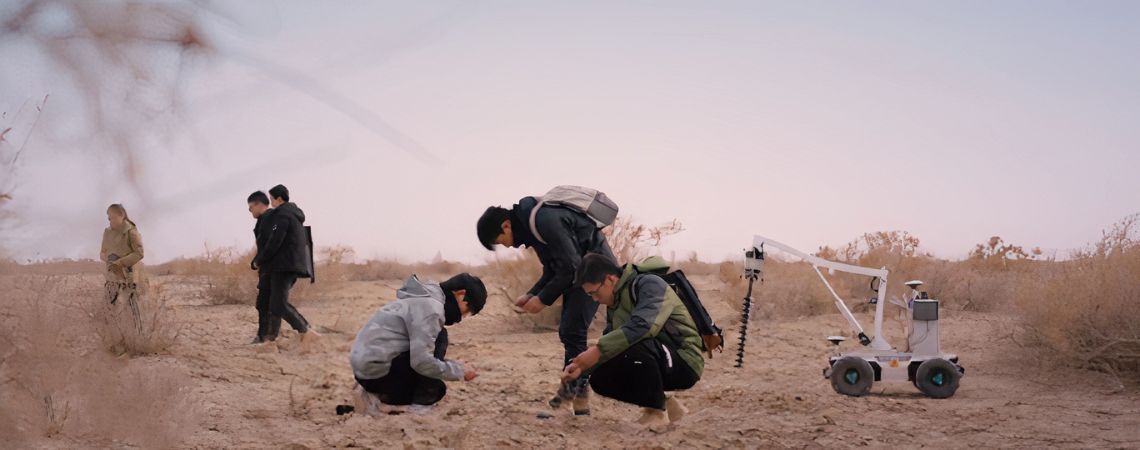Climate change is one of the most disturbing problems of our time. It’s having devastating effects on our planet, marked by episodes of drought, heat waves, extreme rainfall and weaker ecosystems, not to mention desertification and land degradation.
Inappropriate farming practices and global warming are destroying more and more land and diminishing its biological potential. Land desertification affects all continents, but in particular the poorest populations and most arid regions. And a team of scientists at a Chinese university has now designed a tree-planting robot and carried out tests in Mongolia with the aim of transforming more deserts into oases. Read on to find out more!
Robotics and desertification: a solution in the fight against global warming
A team of scientists led by Zhang Xinyu at the East China Normal University has designed and developed a tree-planting robot to conduct planting tests in Alxa, Mongolia. Over a year of research has culminated in 4 robots, able to:
- Dig holes
- Plant trees
- Water the saplings
- Monitor the growth
These 4 robots can operate on a sandy terrain, in all weathers and position themselves to within the nearest centimeter using a GPS system. Remote management, monitoring and data analysis tools allow accurate real-time positioning and regular observation of plants as they grow.
The hole-digging robot is just under 1 meter tall and powered by solar photovoltaic energy. It’s equipped with a large auger drill and is capable of digging tree pits in the vast Alxa desert.
Climate change is one of the most disturbing problems of our time. It’s having devastating effects on our planet, marked by episodes of drought, heat waves, extreme rainfall and weaker ecosystems, not to mention desertification and land degradation.
Inappropriate farming practices and global warming are destroying more and more land and diminishing its biological potential. Land desertification affects all continents, but in particular the poorest populations and most arid regions. And a team of scientists at a Chinese university has now designed a tree-planting robot and carried out tests in Mongolia with the aim of transforming more deserts into oases. Read on to find out more!
Robotics and desertification: a solution in the fight against global warming
A team of scientists led by Zhang Xinyu at the East China Normal University has designed and developed a tree-planting robot to conduct planting tests in Alxa, Mongolia. Over a year of research has culminated in 4 robots, able to:
- Dig holes
- Plant trees
- Water the saplings
- Monitor the growth
These 4 robots can operate on a sandy terrain, in all weathers and position themselves to within the nearest centimeter using a GPS system. Remote management, monitoring and data analysis tools allow accurate real-time positioning and regular observation of plants as they grow.
The hole-digging robot is just under 1 meter tall and powered by solar photovoltaic energy. It’s equipped with a large auger drill and is capable of digging tree pits in the vast Alxa desert.
Robot of choice: the SCOUT 2.0 autonomous mobile robot by AgileX Robotics
The team at the East China Normal University needed a small, lightweight robot capable of functioning in hostile environments and carrying out large-scale, all-day operations unassisted. They naturally chose the SCOUT 2.0 by AgileX Robotics, which has all the technical characteristics necessary for such a project.
The Scout 2.0 offers several features that allow it to adapt to a desert environment:
- A robust chassis that can carry up to 50 kg
- Agile steering with 4-wheel drive and independent suspension
- Low energy consumption
- A new cooling system
- Two communication interfaces (CAN and RS232) for sending motion, steering and secondary development data
The robot’s planting and monitoring system significantly improves planting efficiency, with a guaranteed planted-tree survival rate of over 95%.

Global warming: using robots to plant trees in the desert
Climate change is one of the most disturbing problems of our time. It’s having devastating effects on our planet, marked by episodes of drought, heat waves, extreme rainfall and weaker ecosystems, not to mention desertification and land degradation.
Inappropriate farming practices and global warming are destroying more and more land and diminishing its biological potential. Land desertification affects all continents, but in particular the poorest populations and most arid regions. And a team of scientists at a Chinese university has now designed a tree-planting robot and carried out tests in Mongolia with the aim of transforming more deserts into oases. Read on to find out more!
Robotics and desertification: a solution in the fight against global warming
A team of scientists led by Zhang Xinyu at the East China Normal University has designed and developed a tree-planting robot to conduct planting tests in Alxa, Mongolia. Over a year of research has culminated in 4 robots, able to:
- Dig holes
- Plant trees
- Water the saplings
- Monitor the growth
These 4robots can operate in all weathers and position themselves to within the nearest centimetre using a GPS system. Remote management, monitoring and data analysis tools allow accurate real-time positioning and regular observation of plants as they grow.
The hole-digging robot is just under 1 metre tall and powered by solar photovoltaic energy. It’s equipped with a large auger drill and is capable of digging tree pits in the vast Alxa desert.
Robot of choice: the SCOUT 2.0 autonomous mobile robot by AgileX Robotics
The team at the East China Normal University needed a small, lightweight robot capable of functioning in hostile environments and carrying out large-scale, all-day operations unassisted. They naturally chose the SCOUT 2.0 by AgileX Robotics, which has all the technical characteristics necessary for such a project.
The Scout 2.0 offers several features that allow it to adapt to a desert environment:
- A robust chassis that can carry up to 50 kg
- Agile steering with 4-wheel drive and independent suspension
- Low energy consumption
- A new cooling system
- Two communication interfaces (CAN and RS232) for sending motion, steering and secondary development data
The robot’s planting and monitoring system significantly improves planting efficiency, with a guaranteed planted-tree survival rate of over 95%.
Conclusion
Whether tasked with planting trees, reducing using of chemical fertilisers or carrying heavy loads to relieve employees, robots are gradually becoming more commonplace in our daily lives, providing useful and efficient services for industry and humans. This robot owes its success to the excellent mobile platform designed by AgileX Robotics, which has responded to recent trends by releasing robust and cost-effective autonomous mobile robots that can adapt to all situations.


